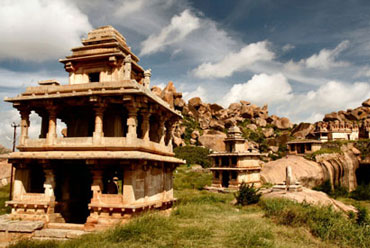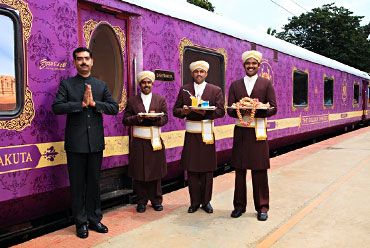Location - Southern side of the Hemakuta group of temples
Timings: 06:00 AM to 06:00 PM (all days of the week)
Entry Fee: Entry is free
Best time to visit: October - February
Known to be the largest statue in Hampi, the Lakshmi Narasimha statue has Narasimha (an incarnation of Lord Vishnu), sitting on the coil of a huge seven-headed snake, called Adishesha. The heads cover the statue in the form of a hood. The Lord is in cross-legged Yoga position with a belt supporting his knees.
The specialty of this imposing sculptures in the ruined town of Hampi is that it is the largest monolith statue here. One of the most important attractions in Hampi, this statue is the rich heritage of the Vijayanagara Empire.
Legends behind Lakshmi Narasimha Statue
Hindu mythology states that Narasimha is the 4th incarnation of Lord Vishnu. He appeared on earth as half human (Nara) and half lion (Simha). While the lower body was of a human, the upper part was like a lion. Placed in the Lakshmi Narasimha temple, this gigantic statue similarly has the face of a fierce lion and the body of a human being.
As far as the angry look on the face of the statue is concerned, there are two theories. One of them suggests that this is an image of Ugra Narasimha or fierce Narasimha and thus it has scary facial expressions with protruding eyes. Moreover, the absence of Goddess Lakshmi along with the Lord, increases the relevance of this theory.
According to the second theory, this sculpture is a representation of Malola Narasimha form where his consort, Goddess Lakshmi is seen sitting on his lap but is not visible as the statue is now damages. The word Malola is a combination of 2 words Ma (Goddess Lakshmi) and Lola (beloved).
History of Lakshmi Narasimha Statue
The statue lies in the Lakshmi Narasimha temple that was constructed in the year 1528, during the reign of Krishnadevaraya, one of the rulers of Vijayanagara Empire. Lord Narasimha and his consort, Goddess Lakshmi are the residing deities of this temple.
Originally, the statue also had a small statues of the Goddess, sitting on his lap. But during the raid by the Mughals in 1565, the statue was highly damaged and disfigured. At the time of the attack the limbs of the statue were also broken and the statue of the Goddess was separated from the main sculpture. Also, one hand of the Goddess’ statue was also broken and this hand can be seen today at the back of the statue of the Lord. This damaged statue of the Goddess today is kept at the Archaeological Museum in Kamalapura.
Architecture of Lakshmi Narasimha Statue
An architectural masterpiece, the Lakshmi Narasimha statue is 6.7 meters in height and has been rafted with amazing details. It is one of the best works that were done in the Vijayanagara style of architecture. The status lies between an arch or Makara torana.
The statue of Lord Narasimha has a clearly-designed mane and wonderfully-shaped broad chest. A well-designed headgear adorns the statue that is seated in cross-legged position. The statue is seated on the soils of seven-hooded holy snake, Adishesha, who is known to be the King of snakes. The hoods of the snake make a canopy on the head of the Lord. On the hood of the snake, a lion mask has been placed.
The protruding and angry eyes of the statue are its important feature and the statue an imposing aura. This huge statue has been carved one single boulder of granite stone and a wonderful piece of craftsmanship.
The temple is placed in the middle of the main road which connects the Sacred Center to the Royal Center.





